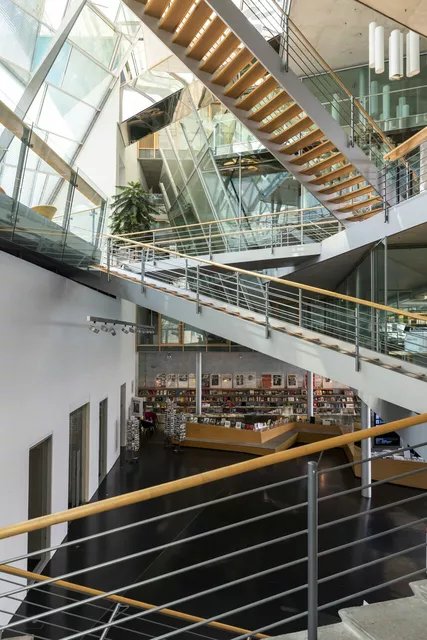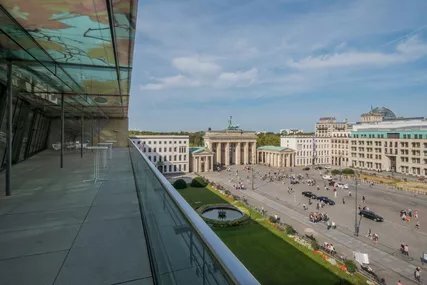
Akademie der Künste on Pariser Platz
Transparency, art and history at the Brandenburg Gate
You can see it straight away: the Akademie der Künste on Pariser Platz is a special building, namely the only one there that is highly glazed and flooded with light between the closed-looking masonry façades of the other buildings. And there is a special reason for this.
For the reconstruction of Pariser Platz after German reunification from 1993, there was a fixed design plan:
The rather sober classicist architecture of the famous Brandenburg Gate was not to be "overshadowed" by neighbouring tall new buildings. The low height of the surrounding buildings was also specified, as was the matt natural stone of the façades, with rows of perforated windows instead of glass façades. A high transparent glass façade was approved here. Why? The transparent glass façade promises that "secret plans" will never again be forged here as they were under National Socialism, when the Akademie der Künste was the workplace of Hitler's favourite architect Albert Speer. A special symbol of transparency and for the freedom of the arts!
The new building by Günther Behnisch at the beginning of the 21st century

The new glass building from 2005 is built in the proportions of its historical predecessor from 1907. The marvellous skylight rooms in the old part are particularly worth seeing. Max Liebermann once presented his works of art here. The exterior façade is completely glazed and therefore superficially modern. But it is precisely this that allows a look back into history and at the same time stands for transparency, rootedness and context.
The building on Pariser Platz is a hub of Berlin's cultural landscape and has great international appeal. It is a meeting place for artists, cultural professionals and their audiences, and is home to the library, the reading room and the archive of architectural art of the Akademie der Künste. A rich programme of events relating to art and culture rounds off the offer.
Long and eventful history
The roots of the Berlin Academy of Arts go back to the late 17th century. From the beginning of the 18th century, it was known as the Königlich-Preußische Akademie der Künste und mechanischen Wissenschaften. After stops at the royal stables on Unter den Linden and in Potsdamer Straße, the academy moved into the quarters on Pariser Platz in 1907. An exhibition building was added to the Palais Arnim and converted for the purposes of the Academy.
The 1920s under the world-famous Impressionist painter and Academy President Max Liebermann can perhaps be considered the golden era of the Academy of Arts. At this time, the Academy opened up to new forms of artistic expression and was also at the forefront of international artistic development. Here, or in the Liebermanns' house diagonally opposite, today's Max Liebermann Haus, everyone who was anyone in the contemporary art scene socialised.
An abrupt end to the heyday
The upswing ended in 1933 with the "Gleichschaltung" of National Socialism. In 1937, the Academy of Arts was forced out of the building on Pariser Platz and the National Socialist grand architect Albert Speer moved in to plan a utopia here undisturbed: Hitler's megalomaniacal idea of a National Socialist capital "Germania" was put on paper here. I
In the final days of the war in 1945, the building was badly damaged and abandoned.
Academy of Arts - in East and West Berlin
After the end of the war and after the division of Germany, the Academy of Arts was revived in various buildings in the eastern and western parts of Berlin. At the end of the 1950s, the famous Berlin architect Werner Düttmann built the Akademie der Künste am Hanseatenweg in the Hansaviertel district of West Berlin, which is now recognised as an icon of post-war architecture in Berlin. Meanwhile, its former headquarters on Pariser Platz fell into disrepair. Nevertheless, artistic work continued there. Members and master students of the Academy of Arts (East) moved into the ruins and set up workshops and studios.
In 1957 and 1958, budding artists celebrated and immortalised themselves on the walls of the Academy's rambling basement rooms on Pariser Platz. Their works can be seen today in the academy's "picture cellar". After the wall was built in 1961, the building lay abandoned and inaccessible in the no-man's land of the Berlin border strip.
The rebirth of the academy
After the fall of the Wall, it was not only the reunification of Germany that was celebrated. The two opposing academies of the arts in the eastern and western parts of the city were also reunited as one institution. Nevertheless, it took more than 15 years before the reunited Academy of Arts transferred to federal sponsorship in 2005. This paved the way for Günter Behnisch's plans for a new building.

Highlights
- Cellar paintings in the branching catacombs of the building
- Restored skylight rooms
- Terrace on the upper floor with a view of Pariser Platz
- Food and drinks at Café Liebermann on the ground floor
Your visit
How to get there: Brandenburger Tor S+U train station
Daily 10 am - 8 pm
Access to the building and the exhibition rooms is barrier-free. Visitors under the age of 18 have free admission to the exhibitions.
More culture nearby
The main attraction on Pariser Platz and Berlin's landmark is the Brandenburg Gate. Right next to it you will find the Max Liebermann Haus, where you can see an exhibition on the life and fate of the world-famous Jewish Impressionist. If you walk through the Akademie der Künste from Pariser Platz, on the other side of the street, you will come across the Memorial to the Murdered Jews of Europe with its moving underground documentation centre, underground documentation centre.
